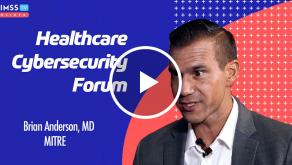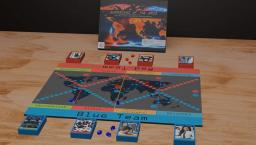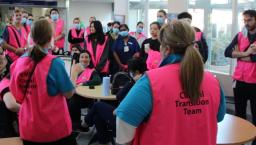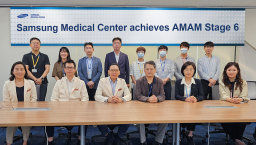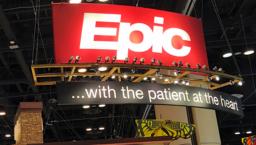UVA Health transforms plain text radiology reports into multimedia, gaining clinical ROI

Musculoskeletal imaging at UVA Health System
Photo: UVA Health System
Back in 2018, Healthcare IT News reported on how the University of Virginia (UVA) Health System, based in Charlottesville, had completed implementation of new reporting technology that enabled radiologists to create next-generation reports containing rich elements.
CATCHING UP WITH UVA
Radiology reporting was, and still is, behind. Plain text is the standard format in the industry.
UVA Health added the option to enhance reports, just like one would encounter with any news article on the internet today. It added text formatting, key images, tables, figures and hypertext connecting important findings in the report to annotated images in the PACS. It also added a signing radiologist photograph to increase professional visibility.
"In 2018, we faced two main issues," noted Dr. Cree Gaskin, associate chief medical information officer, vice-chair of informatics and operations, and division director of musculoskeletal imaging. "The first was technical. While we were successful in creating interactive multimedia reports, sharing them downstream in an ideal format was another issue.
"We relied on the PDF format to pass the rich content from our reporting application to our EHR," he continued. "To see the advanced report content, providers had to use a third-party PDF viewer integrated with the EHR. The solution worked but had room for improvement. We wanted the content more rapidly and directly visible within the EHR, just like plain text reports."
The second issue was adoption. UVA Health wanted to increase how often the technology was being leveraged. It sought higher rates of advanced report creation by radiologists and greater exposure of these reports to referring providers and patients.
PROPOSAL
Rich digital content creation is so ubiquitous today that it can be hard to understand how report formatting was, and still is, a barrier in radiology.
"As a very early adopter of interactive multimedia reporting, we faced issues due to the lack of industry standards, and we were asking our vendors to do more than had been done before," Gaskin said. "Nearly every institution and radiology practice is still using plain text for radiology reporting, because it’s better supported and easy to share the content across vendors.
"I believe we were successful as an early adopter because our reporting application was integrated with our PACS viewer."
Dr. Cree Gaskin, UVA Health System
"While PDF was a working solution for our advanced reports, it was slower and required use of a third-party viewer, rather than offering dynamic content directly within the EHR itself," he continued. "We worked with the R&D teams from both our reporting and EHR vendors to come to an agreement on how to share and display the reporting content."
Staff decided on the use of the RTF format to create, share and display RTF radiology reports.
"Each vendor completed minor development, and then we all collaborated for final implementation," Gaskin recalled. "Initially, there were display problems for some advanced report elements, having been created in one vendor’s reporting application and displayed in another vendor’s EHR. We were generally able to resolve these formatting issues through alignment in configuration.
"For the second issue, that of increasing adoption, we took a few different steps," he continued. "Because it's important that radiologists understand the benefits of and have fluency in creating advanced reports, we increased visibility in the department through dedicated conferences and sharing of electronic how-to guides."
Staff emphasized how the advanced reports benefit patients, providers and radiologists through greater clarity and greatly shortened review time. Furthermore, while some were concerned it would take additional time to create advanced reports, staff emphasized how many of the tools can actually expedite report creation workflow while reducing reporting errors.
"We also worked with our EHR vendor to ensure the advanced report elements would be visible to and functional for our patients via the EHR patient portal, not just available to our providers in the main EHR," Gaskin said. "That took minor development by the vendor, but the result is that patients also see this content.
"By placing interactive multimedia reports in front of providers, radiologists and patients in the EHR, the utilization of the features goes up substantially," he noted. "It almost goes without saying that the advanced elements aren’t used if they aren't being seen.
"So, it's important they are readily accessible," he added. "The visibility increases adoption. Radiologists are more likely to make advanced reports if they are being used by our consumers."
RESULTS
UVA Health has collected data on how often radiologists create reports with interactive elements.
"We have solid adoption across the department, though we observe interactive elements are more commonly placed in MRI, CT and PET-CT reports," he said. "For example, 66-78% of our abdominal CTs, chest MRIs and PET-CTs have interactive links to key findings.
"This is really high adoption, especially when you consider some studies are negative and don't warrant any link creation at all," he continued. "This is a very compelling argument that our radiologists find this tool to be useful."
Staff has begun preliminary investigation of how often these links are used downstream by consumers once they are created. Preliminarily, the links are getting about two activations in the EHR for every report created with hyperlinks. So, staff knows providers and patients are commonly clicking the links.
"I don’t have hard data on radiologist usage of the links after they have been created, but anecdotally I can tell you it's strong," Gaskin said. "From my own experience, I find it disappointing when I encounter prior reports without interactive elements because it takes longer for me to find what the previous radiologist was talking about in the report.
"When reviewing comparison studies, it's much faster and more reliable just to click a link and instantly see it," he added. "Once you get used to advanced reporting, it can be hard to go without. Radiologists who have left UVA have told me how they miss being able to effortlessly pass information from the viewer (the PACS) into the report in an integrated system like we have."
It's faster and has no chance for transcription error compared with doing it manually, Gaskin said.
"Finally, plain text reports are exactly that – they are plain," he noted. "The advanced reports look better and are more engaging. It can be more fun and satisfying to create a better product."
ADVICE FOR OTHERS
The report is the primary work product of the diagnostic radiologist.
"It seems very natural to move forward in any direction that improves report quality," Gaskin advised. "It’s obviously an improvement to move past plain text if you can. Beyond my own opinion here, multiple other opinions have appeared in the literature over the last several decades and all agree.
"But it's easier said than done," he continued. "Some past attempts have failed because of cumbersome workflow. Radiologists aren't going to adopt it unless it’s easy enough to use. It’s very important to consider radiologist workflow when considering products and implementation."
Also, radiologists might not be interested in going through the hassle of adoption if their customers aren't requesting it, he added. Since plain text reports are so ubiquitous, referring providers often don't even know they could push for this type of report. Since it's so new, it takes some leadership to overcome the inertia and change, he said.
"Finally, I believe we were successful as an early adopter because our reporting application was integrated with our PACS viewer," he said. "We chose this path because we believed it was an advantaged position for efficient interactive multimedia reporting.
"Many practices have reporting applications that are separate from their PACS viewer, which adds additional technical and workflow challenges," he concluded.
Follow Bill's HIT coverage on LinkedIn: Bill Siwicki
Email him: bsiwicki@himss.org
Healthcare IT News is a HIMSS Media publication.









